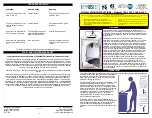
6
∙
Julien
∙
Installation and Care Guide / Guide d’installation et d'entretien
Installation
step 1
assemble the spray head
Screw the head spray onto the tip of the flexible hose,
located at the top part of the faucet. Be sure to add a seal
washer or washer with mesh between the two parts.
For water savings,
use the seal washer with mesh.
For normal flow,
use regular seal washer.
step 2
install the faucet
Insert the O-ring below the faucet body. First, insert the mixed
water outlet followed by the flexible hoses and the threaded
rod of the faucet into the hole on your sink or countertop
and secure the faucet with the mounting kit, as shown
(Julien recommends drilling a 1
3
∕
8
” diameter hole for the inser-
tion of the faucet).
If the thickness of the surface on which you install the
faucet is smaller than 5 mm (
3
∕
16
”), use the plastic holder.
Otherwise, omit it.
step 3
Connect hot and cold flexible hoses
Connect the hose identified by a red sticker into the hot
water outlet of the water supply line. Connect the second
hose into the remaining tip of the supply line, as shown.
Use the two adaptor assemblies, if necessary.
attention
Be careful not to bend or twist the flexible hoses.
step 4
Connect the retractable spray head
Insert the seal washer into the mixed water outlet, exceeding
from the faucet body. Screw the brass nut into the threaded
rod of the mixed water outlet. Then, add a seal washer
between the spray head flexible hose and the brass nut
and screw the two tips.
Now, attach the lead counterweight to the spray head hose
with the screws supplied. Be sure to add the transparent
plastic part underneath the counterweight, between the two
parts, to avoid slipping.
If necessary, adjusts its position
and/or add the second counterweight to optimize the
tension of the spray head.
Installation
Étape 1
assemblez le bec pulvérisateur
Vissez le bec pulvérisateur sur l’embout du flexible d’alimen-
tation, dans la partie supérieure du robinet, en prenant soin
de placer une rondelle d’étanchéité, munie ou non d’une grille,
entre les deux parties.
Pour une économie d’eau,
utilisez la rondelle avec grillage.
Pour un débit normal,
utilisez la rondelle régulière.
Étape 2
installez le robinet
Insérez le joint torique sous le corps du robinet, tel qu’illustré.
Faites d’abord passer la sortie d’eau mixte puis les flexibles
d’alimentation et la tige filetée du robinet dans le trou prévu
à cet effet et fixez le robinet avec les pièces nécessaires à
l'assemblage, tel qu’illustré (Julien recommande le perçage
d’un trou de 1
3
∕
8
” de diamètre pour l’insertion du robinet).
Si l’épaisseur de la surface sur laquelle vous installez le robinet
est plus petite que 5 mm (
3
∕
16
”), utilisez le support en plastique.
Dans le cas contraire, omettez-le.
Étape 3
Connectez les flexibles d’alimentation
d’eau chaude et froide
Connectez le flexible identifié par un collant rouge à la sortie
d’eau chaude de la ligne d’alimentation en eau. Connectez
le deuxième flexible à l’embout restant de la ligne d’alimenta-
tion, tel qu’illustré. Utilisez les deux assemblages de l’adap-
tateur, si nécessaire.
attention
Ne pas plier ou tordre les flexibles.
Étape 4
Connectez le bec pulvérisateur rétractable
Insérez l’anneau d’étanchéité dans la borne filetée de la sortie
d’eau mixte, dépassant du corps du robinet. Vissez l’écrou
en laiton dans la borne filetée de la sortie d’eau mixte.
Placez ensuite un anneau d’étanchéité entre le flexible d’ali-
mentation du bec pulvérisateur et l’écrou en laiton et vissez
les deux embouts.
Fixez ensuite le contrepoids sur le flexible d’alimentation
du bec pulvérisateur avec les vis fournies en vous assurant
d’ajouter le morceau de plastique transparent entre les
deux parties. Cela empêchera le contrepoids de glisser.
Si nécessaire, ajustez sa position et/ou ajoutez le second
contrepoids pour optimiser la tension du bec
.






























